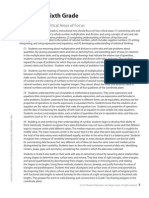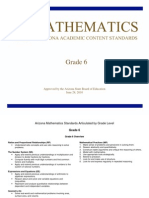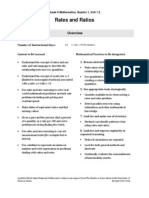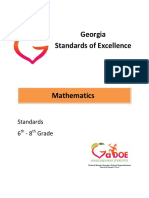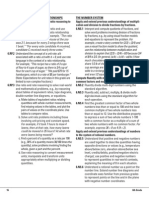0 ratings0% found this document useful (0 votes)
230 viewsCommon Core Math
Uploaded by
api-268879403Copyright
© © All Rights Reserved
Available Formats
Download as DOC, PDF, TXT or read online on Scribd
0 ratings0% found this document useful (0 votes)
230 viewsCommon Core Math
Uploaded by
api-268879403Copyright
© © All Rights Reserved
Available Formats
Download as DOC, PDF, TXT or read online on Scribd
You are on page 1/ 3
Grade 6 Introduction
PRINT THIS PAGE
In Grade 6, instructional time should focus on four critical areas: (1) connecting
ratio and rate to whole number multiplication and division and using concepts of
ratio and rate to solve problems; (2) completing understanding of division of
fractions and etending the notion of number to the s!stem of rational numbers,
which includes negative numbers; (") writing, interpreting, and using epressions
and e#uations; and ($) developing understanding of statistical thin%ing&
1& 'tudents use reasoning about multiplication and division to solve ratio and
rate problems about #uantities& (! viewing e#uivalent ratios and rates as
deriving from, and etending, pairs of rows (or columns) in the multiplication
table, and b! anal!)ing simple drawings that indicate the relative si)e of
#uantities, students connect their understanding of multiplication and division
with ratios and rates& *hus students epand the scope of problems for which
the! can use multiplication and division to solve problems, and the! connect
ratios and fractions& 'tudents solve a wide variet! of problems involving ratios
and rates&
2& 'tudents use the meaning of fractions, the meanings of multiplication and
division, and the relationship between multiplication and division to understand
and eplain wh! the procedures for dividing fractions ma%e sense& 'tudents use
these operations to solve problems& 'tudents etend their previous
understandings of number and the ordering of numbers to the full s!stem of
rational numbers, which includes negative rational numbers, and in particular
negative integers& *he! reason about the order and absolute value of rational
numbers and about the location of points in all four #uadrants of the coordinate
plane&
"& 'tudents understand the use of variables in mathematical epressions&
*he! write epressions and e#uations that correspond to given situations,
evaluate epressions, and use epressions and formulas to solve problems&
'tudents understand that epressions in different forms can be e#uivalent, and
the! use the properties of operations to rewrite epressions in e#uivalent
forms& 'tudents %now that the solutions of an e#uation are the values of the
variables that ma%e the e#uation true& 'tudents use properties of operations
and the idea of maintaining the e#ualit! of both sides of an e#uation to solve
simple one+step e#uations& 'tudents construct and anal!)e tables, such as
tables of #uantities that are in e#uivalent ratios, and the! use e#uations (such as
"x , y) to describe relationships between #uantities&
$& (uilding on and reinforcing their understanding of number, students begin
to develop their abilit! to thin% statisticall!& 'tudents recogni)e that a data
distribution ma! not have a de-nite center and that different wa!s to measure
center !ield different values& *he median measures center in the sense that it is
roughl! the middle value& *he mean measures center in the sense that it is the
value that each data point would ta%e on if the total of the data values were
redistributed e#uall!, and also in the sense that it is a balance point& 'tudents
recogni)e that a measure of variabilit! (inter#uartile range or mean absolute
deviation) can also be useful for summari)ing data because two ver! different
sets of data can have the same mean and median !et be distinguished b! their
variabilit!&
'tudents learn to describe and summari)e numerical data sets, identif!ing
clusters, pea%s, gaps, and s!mmetr!, considering the contet in which the data
were collected& 'tudents in Grade 6 also build on their wor% with area in
elementar! school b! reasoning about relationships among shapes to
determine area, surface area, and volume& *he! -nd areas of right triangles,
other triangles, and special #uadrilaterals b! decomposing these shapes,
rearranging or removing pieces, and relating the shapes to rectangles& .sing
these methods, students discuss, develop, and /ustif! formulas for areas of
triangles and parallelograms& 'tudents -nd areas of pol!gons and surface areas
of prisms and p!ramids b! decomposing them into pieces whose area the! can
determine& *he! reason about right rectangular prisms with fractional side
lengths to etend formulas for the volume of a right rectangular prism to
fractional side lengths& *he! prepare for wor% on scale drawings and
constructions in Grade 0 b! drawing pol!gons in the coordinate plane&
Grade 6 Overview
1atios and 2roportional 1elationships
.nderstand ratio concepts and use ratio reasoning to solve problems&
*he 3umber '!stem
4ppl! and etend previous understandings of multiplication and division to
divide fractions b! fractions&
5ultipl! and divide multi+digit numbers and -nd common factors and
multiples&
4ppl! and etend previous understandings of numbers to the s!stem of
rational numbers&
6pressions and 6#uations
4ppl! and etend previous understandings of arithmetic to algebraic
epressions&
1eason about and solve one+variable e#uations and ine#ualities&
1epresent and anal!)e #uantitative relationships between dependent and
independent variables&
Geometr!
'olve real+world and mathematical problems involving area, surface area,
and volume&
'tatistics and 2robabilit!
7evelop understanding of statistical variabilit!&
'ummari)e and describe distributions&
5athematical 2ractices
1& 5a%e sense of problems and persevere in solving them&
2& 1eason abstractl! and #uantitativel!&
"& 8onstruct viable arguments and criti#ue the reasoning of others&
$& 5odel with mathematics&
9& .se appropriate tools strategicall!&
6& 4ttend to precision&
0& :oo% for and ma%e use of structure&
;& :oo% for and epress regularit! in repeated reasoning&
You might also like
- Mathematics - Grade 6: X Y) To Describe Relationships BetweenNo ratings yetMathematics - Grade 6: X Y) To Describe Relationships Between7 pages
- Mathematics - Grade 6: X Y) To Describe Relationships BetweenNo ratings yetMathematics - Grade 6: X Y) To Describe Relationships Between7 pages
- New Jersey Student Learning Standards Mathematics - Grade 6No ratings yetNew Jersey Student Learning Standards Mathematics - Grade 618 pages
- Tennessee's State Mathematics Standards - Grade 7No ratings yetTennessee's State Mathematics Standards - Grade 74 pages
- FREEMATHCommonCoreStateStandards68Checklist 1 PDFNo ratings yetFREEMATHCommonCoreStateStandards68Checklist 1 PDF19 pages
- Office of Curriculum and Instruction: Grade Seven MathematicsNo ratings yetOffice of Curriculum and Instruction: Grade Seven Mathematics20 pages
- [Parents Version] Course Outline 2024-2025 -VAP 6 - MATHNo ratings yet[Parents Version] Course Outline 2024-2025 -VAP 6 - MATH18 pages
- Grade Six Indicators For The Mathematics Standard Course of StudyNo ratings yetGrade Six Indicators For The Mathematics Standard Course of Study56 pages
- 3 Grade Math Common Core Standards: At-A-Glance Operations & Algebraic ThinkingNo ratings yet3 Grade Math Common Core Standards: At-A-Glance Operations & Algebraic Thinking4 pages
- Teaching To The Math Common Core State Standards - Focus On Grade 5 To Grade 8 and Algebra 1 PDF100% (1)Teaching To The Math Common Core State Standards - Focus On Grade 5 To Grade 8 and Algebra 1 PDF228 pages
- Year 9 Concept Review Video Links - 2024_25No ratings yetYear 9 Concept Review Video Links - 2024_253 pages
- Year 6 Mathematics Judging Standards Assessment-PointersNo ratings yetYear 6 Mathematics Judging Standards Assessment-Pointers5 pages
- 24-25 - G7 - Schedule and Syllabus For Second Term ExamNo ratings yet24-25 - G7 - Schedule and Syllabus For Second Term Exam1 page
- 5d83b1c15171b377aa794c5c - Mathematics Third GradeNo ratings yet5d83b1c15171b377aa794c5c - Mathematics Third Grade5 pages
- Principles and Standards For School Mathematics (NCTM) - 230-237No ratings yetPrinciples and Standards For School Mathematics (NCTM) - 230-2378 pages
- Updated Mathematics Syllabus For Regional and National Level MSM 2024No ratings yetUpdated Mathematics Syllabus For Regional and National Level MSM 20243 pages
- New Budget of Work in Mathematics For Grade FiveNo ratings yetNew Budget of Work in Mathematics For Grade Five8 pages
- Mathematics Vertical Articulation Document (Dec 2023)No ratings yetMathematics Vertical Articulation Document (Dec 2023)56 pages
- GRADE 5 Most Essential Learning Competencies100% (2)GRADE 5 Most Essential Learning Competencies4 pages
- GCSE Maths Syllabus Eight Subject Areas Explained in DetailNo ratings yetGCSE Maths Syllabus Eight Subject Areas Explained in Detail1 page
- Elementary School ‘Grades 3, 4 & 5: Math – Publications Guide - Ages 8-11’ eBookFrom EverandElementary School ‘Grades 3, 4 & 5: Math – Publications Guide - Ages 8-11’ eBookNo ratings yet
- TS - JR - Maths Ib - Imp Questions-2023 PDF100% (1)TS - JR - Maths Ib - Imp Questions-2023 PDF7 pages
- Tutorial Joint Push Pull - English - V1.1 - 20 Feb 08No ratings yetTutorial Joint Push Pull - English - V1.1 - 20 Feb 0831 pages
- Application of Determinant To Determine The Area of PlaneNo ratings yetApplication of Determinant To Determine The Area of Plane14 pages
- Properties of Triangles and Quadrilaterals: Let's Check Your Understanding! Grade 5 MathematicsNo ratings yetProperties of Triangles and Quadrilaterals: Let's Check Your Understanding! Grade 5 Mathematics28 pages
- Download ebooks file (Ebook) Pottery Style and Society in Ancient Peru by Dorothy Menzel ISBN 9780520338241, 0520338243 all chapters100% (3)Download ebooks file (Ebook) Pottery Style and Society in Ancient Peru by Dorothy Menzel ISBN 9780520338241, 0520338243 all chapters81 pages
- ELECTIVE-MATHEMATICS-10-Module-3 Analytic ProofsNo ratings yetELECTIVE-MATHEMATICS-10-Module-3 Analytic Proofs21 pages
- Concise Selina Solutions For Class 9 Maths Chapter 15 Construction of PolygonsNo ratings yetConcise Selina Solutions For Class 9 Maths Chapter 15 Construction of Polygons21 pages
- LR 16 Maths E3 2d3d Shapes and PerimeterNo ratings yetLR 16 Maths E3 2d3d Shapes and Perimeter14 pages
- 100 Geometry Problems: Solutions: Alvin ZouNo ratings yet100 Geometry Problems: Solutions: Alvin Zou26 pages
- MYP 2 - Unit 2 Geometry and Measurements OverviewNo ratings yetMYP 2 - Unit 2 Geometry and Measurements Overview5 pages
- Third Space Learning Lines of Symmetry GCSE WorksheetNo ratings yetThird Space Learning Lines of Symmetry GCSE Worksheet15 pages
- 05 - Coordinate Geometry Practice WS - 1No ratings yet05 - Coordinate Geometry Practice WS - 12 pages


